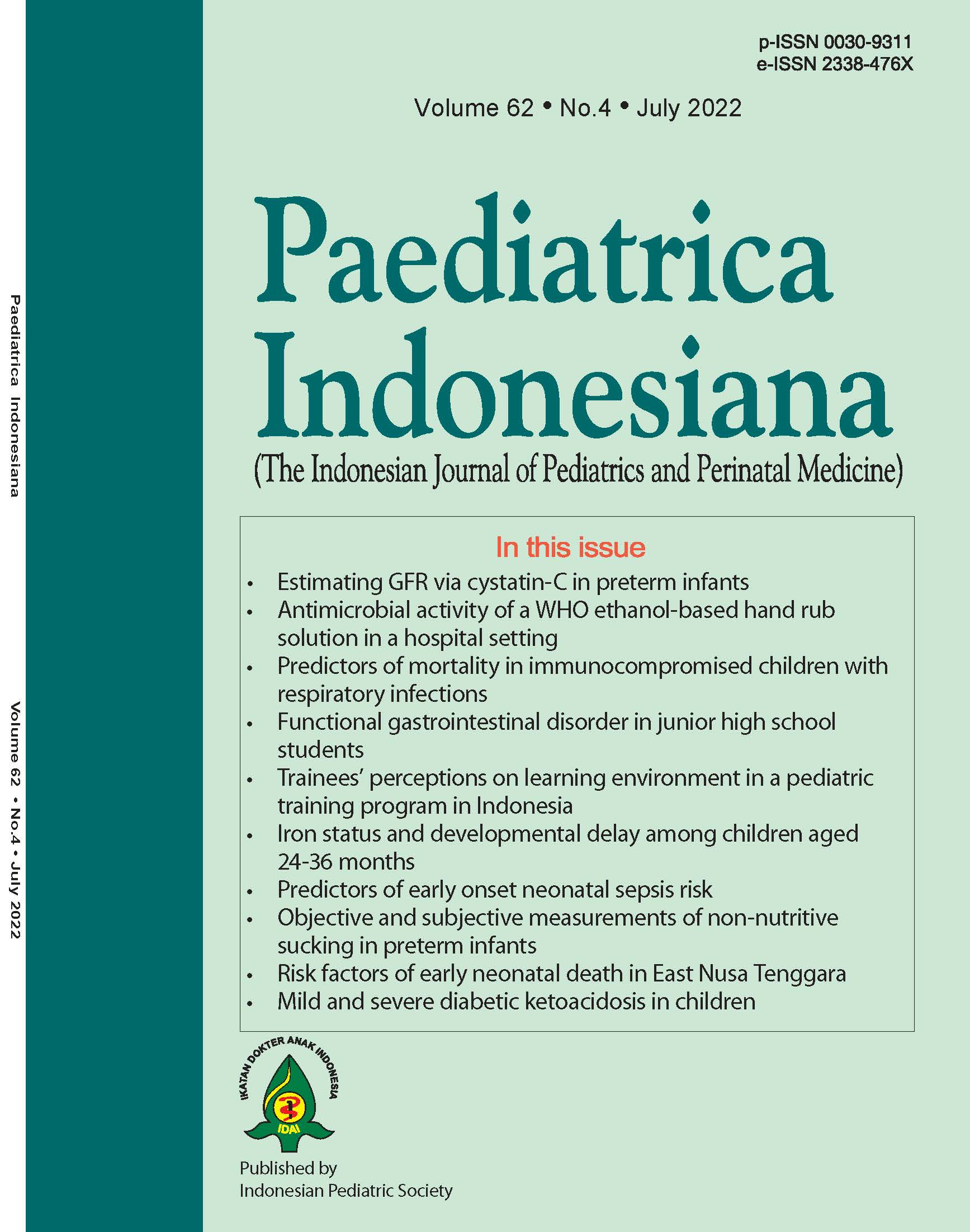A comparison of objective and subjective measurements of non-nutritive sucking in preterm infants
DOI:
https://doi.org/10.14238/pi62.4.2022.274-81Keywords:
preterm infants, non-nutritive suckingAbstract
Background Of preterm infants born before 32 weeks of gestation, 40-70% have atypical and immature feeding skills, which could delay initiation of oral feeding. A formal objective measurement of non-nutritive sucking may increase the accuracy of determining the right time to initiate oral feeding, however, most hospital perinatology care units do not own a suction pressure measurement device to objectively measure non-nutritive sucking parameters.
Objective To compare objective and subjective non-nutritive sucking (NNS) based on sucking pressure, number of suctions per burst, and time between bursts.
Methods One hundred twenty preterm infants born at 28-34 weeks’ gestation were evaluated for objective and subjective NNS. Data were collected from August to November 2021 at five hospitals in Jakarta. Objective NNS was measured by a suction pressure measurement device, while subjective NNS was clinically examined. Number of suctions per burst, sucking pressure, and time between bursts were analysed by Spearman’s correlation test.
Results A positive and significant correlation between objective and subjective NNS was found in all parameters (P<0.001). The highest correlation was found in time between bursts (r=0.74; P<0.001), followed by number of suctions per burst (r=0.60; P<0.001), and sucking pressure (r=0.58; P<0.001).
Conclusion The correlation between objective and subjective NNS examination was moderate in preterm infants. Therefore, an objective NNS measurement is still required for optimizing the examination.
References
2. Capilouto GJ, Cunningham TJ, Giannone PJ, Grider D. A comparison of the nutritive sucking performance of full term and preterm neonates at hospital discharge: a prospective study. Early Hum Dev. 2019;134:26–30. DOI: https://doi.org/10.1016/j.earlhumdev.2019.05.007.
3. Einarsson-Backes LM, Deitz J, Price R, Glass R, Hays R. The effect of oral support on sucking efficiency in preterm infants. Am J Occup Ther. 2017;48:490–8. DOI: https://doi.org/10.5014/ajot.48.6.490.
4. Lau C. Development of suck and swallow mechanisms in infants. Ann Nutr Metab. 2015;66 Suppl 5:7–14. DOI: https://doi.org/10.1159/000381361.
5. Lau C, Hurst N. Oral feeding in infants. Curr Probl Pediatr. 1999;29:105–24. DOI: https://doi.org/10.1016/s0045-9380(99)80052-8.
6. Wolf LS, Glass RP. Feeding and swallowing disorder in infancy: assessment and management. Tucson: Therapy Skill Builders; 1992. p.181.
7. Thoyre SM, Carlson JR. Preterm infants’ behavioural indicators of oxygen decline during bottle feeding. J Adv Nurs. 2003;43:631–41. DOI: https://doi.org/10.1046/j.1365-2648.2003.02762.x.
8. Comrie JD, Helm JM. Common feeding problems in the intensive care nursery: maturation, organization, evaluation, and management strategies. Semin Speech Lang. 1997;18:239-60. DOI: https://doi.org/10.1055/s-2008-1064075.
9. Gouna G, Rakza T, Kuissi E, Pennaforte T, Mur S, Storme L. Positioning effects on lung function and breathing pattern in premature newborns. J Pediatr. 2013;162:1133–7.e1. DOI: https://doi.org/10.1016/j.jpeds.2012.11.036.
10. Wolff PH. The serial otganization of sucking in the young infant. Pediatrics. 1968;42:943–56. PMID: 4235770.
11. Mizuno K, Ueda A. The maturation and coordination of sucking, swallowing, and respiration in preterm infants. J Pediatr. 2003;142:36–40. DOI: https://doi.org/10.1067/mpd.2003.mpd0312.
12. Pineda R, Dewey K, Jacobsen A, Smith J. Non-nutritive sucking in the preterm infant. Am J Perinatol. 2019;36: 268–76. DOI: https://doi.org/10.1055/s-0038-1667289.
13. Koo TK, Li MY. A guideline of selecting and reporting intraclass correlation coefficients for reliability research. J Chiropr Med. 2016;15:155-63. DOI: https://doi.org/10.1016/j.jcm.2016.02.012.
14. Naeye R, Burt L, Wright D, Blanc W, Tatter D. Neonatal mortality, the male disadvantage. Pediatrics. 1971;48:902–6. PMID: 5129451.
15. Brothwood M, Wolke D, Gamsu H, Benson J, Cooper D. Prognosis of the very low birthweight baby in relation to gender. Arch Dis Child. 1986;61:559–64. DOI: https://doi.org/10.1136/adc.61.6.559.
16. Stevenson DK, Verter J, Fanaroff AA, Oh W, Ehrenkranz RA, Shankaran S, et al. Sex differences in outcomes of very low birthweight infants: the newborn male disadvantage. Arch Dis Child Fetal Neonatal Ed. 2000;83:F182-5. DOI: https://doi.org/10.1136/fn.83.3.f182.
17. Masato I, Tamura M, Namba F. Role of sex in morbidity and mortality of very premature neonates. Pediatr Int. 2017;59:898–905. DOI: https://doi.org/10.1111/ped.13320.
18. Estep M, Barlow SM, Vantipalli R, Finan D, Lee J. Non-nutritive suck parameters in preterm infants with RDS. J Neonatal Nurs. 2008;14:28–34. DOI: https://doi.org/10.1016/j.jnn.2007.12.005.
19. Hafstrom M, Kjellmer I. Non-nutritive sucking in the healthy pre-term infant. Early Hum Dev. 2000;60:13–24. DOI: https://doi.org/10.1016/s0378-3782(00)00091-8.
20. Medoff-Cooper B, Verklan T, Carlson S. The development of sucking patterns and physiologic correlates in very-low-birth-weight infants. Nurs Res. 1993;42:100–5. PMID: 8455984.
21. Matsubara M, Tamura Y, Ruchala P. Analysis of nutritive sucking function in very low and extremely low birthweight infants in Japan: a pilot study. Japan J Nurs Sci. 2005;2:3–7. DOI: https://doi.org/10.1111/j.1742-7924.2005.00026.x.
22. Medoff-Cooper B. Changes in nutritive sucking patterns with increasing gestational age. Nurs Res. 1991;40:235–7. PMID: 1857653.
23. Lau C, Smith E, Schanler R. Coordination of suck-swallow and swallow respiration in preterm infants. Acta Paediatr. 2003;92:721–7. DOI: https://doi.org/10.1080/08035250310002407.
24. Reynolds EW, Grider D, Caldwell R, Capilouto G, Vijaygopal P, Patwardhan A, et al. Swallow – breath interaction and phase of respiration with swallow during nonnutritive suck among low-risk preterm infants. Am J Perinatol. 2010;27:831–40. DOI: https://doi.org/10.1055/s-0030-1262504.
25. Prechtl HF. Qualitative changes of spontaneous movements in fetus and preterm infant are a marker of neurological dysfunction. Early Hum Dev. 1990;23:151–8. DOI: https://doi.org/10.1016/0378-3782(90)90011-7.
26. Lau C, Kusnierczyk I. Quantitative evaluation of infant’s nonnutritive and nutritive sucking. Dysphagia. 2001;16:58–67. DOI: https://doi.org/10.1007/s004550000043.
Downloads
Published
How to Cite
Issue
Section
License
Authors who publish with this journal agree to the following terms:
Authors retain copyright and grant the journal right of first publication with the work simultaneously licensed under a Creative Commons Attribution License that allows others to share the work with an acknowledgement of the work's authorship and initial publication in this journal.
Authors are able to enter into separate, additional contractual arrangements for the non-exclusive distribution of the journal's published version of the work (e.g., post it to an institutional repository or publish it in a book), with an acknowledgement of its initial publication in this journal.
Accepted 2022-08-26
Published 2022-08-26


















